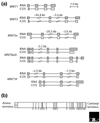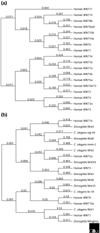The Wnts
- PMID: 11806834
- PMCID: PMC150458
- DOI: 10.1186/gb-2001-3-1-reviews3001
The Wnts
Abstract
The Wnt genes encode a large family of secreted protein growth factors that have been identified in animals from hydra to humans. In humans, 19 WNT proteins have been identified that share 27% to 83% amino-acid sequence identity and a conserved pattern of 23 or 24 cysteine residues. Wnt genes are highly conserved between vertebrate species sharing overall sequence identity and gene structure, and are slightly less conserved between vertebrates and invertebrates. During development, Wnts have diverse roles in governing cell fate, proliferation, migration, polarity, and death. In adults, Wnts function in homeostasis, and inappropriate activation of the Wnt pathway is implicated in a variety of cancers.
Figures



References
-
- The Genome Database. http://gdbwww.gdb.org/gdb/ The Genome Database (GDB) is the official central repository for genomic mapping data resulting from the Human Genome Initiative.
-
- SOURCE. http://genome-www4.stanford.edu/cgi-bin/SMD/source/sourceSearch The Stanford Online Universal Resource for Clones and ESTs (SOURCE) compiles information from several publicly accessible databases, including UniGene, dbEST, SWISSPROT, GeneMap99, RHdb, GeneCards and LocusLink to provide a scientific resource that pools publicly available data commonly sought after for any clone, GenBank accession number, or gene.
-
- GenBank. http://www.ncbi.nlm.nih.gov/Genbank/index.html Database of DNA and protein sequences.
-
- GeneCards. http://genome-www.stanford.edu/genecards/index.html GeneCards™ is a database of human genes, their products and their involvement in diseases.
-
- The Wnt gene homepage. http://www.stanford.edu/~rnusse/wntwindow.html An excellent resource for information on genes involved in Wnt signal transduction. The site provides comprehensive information on Wnt ligands and Fzd receptors as well as genes involved in Wnt/β-catenin signaling.
Publication types
MeSH terms
Substances
LinkOut - more resources
Full Text Sources
Other Literature Sources

